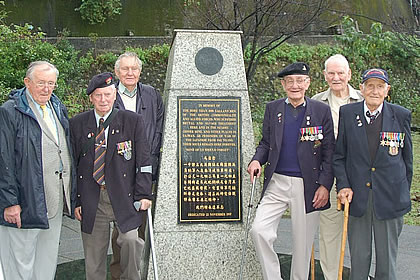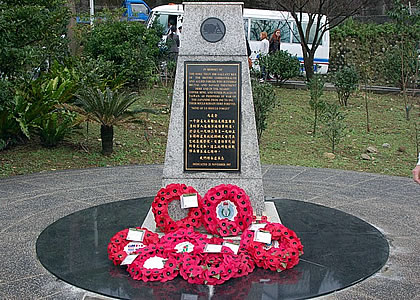The Men of Kinkaseki
THESE ENTRIES ARE CONTRIBUTED BY MIKE HEATHER, SON-IN-LAW OF KEN PETT. KEN WAS ONE OF THE POWs LIBERATED FROM FORMOSA BY THE KRETCHMER IN 1945.
September 5th 1945. A date these men will never forget.
USS Kretchmer and USS Thomas J Gary made their way into Keelung harbour slowly through the minefields. The men of Kinkaseki POW camp were not aware of the dangers the crews had gone through, all they knew was that "Uncle Sam's Boys" had come to take them off Devils Island" (a quote by Ken Pett in his first letter home to his Mum after rescue)
 The men had arrived on Formosa in November 1942. 1,100 men packed into the hold of the "England Maru", an old rusting tub that had previously been used for transporting cattle, and the men were treated as similar animals on this three week voyage. Dysentery was rife, and the only facilities were a plank that hung out over the sea. The men had arrived on Formosa in November 1942. 1,100 men packed into the hold of the "England Maru", an old rusting tub that had previously been used for transporting cattle, and the men were treated as similar animals on this three week voyage. Dysentery was rife, and the only facilities were a plank that hung out over the sea.
Upon landing the men were split into 2 groups, with 523 being sent straight to Kinkaseki Camp, and the remainder to another camp in Taipei. Kinkaseki was the site of the most productive copper mine in Japan hands, and they were to become the unpaid workforce for the Japanese war effort. From day one the men had their uniforms removed, and were made to wear shorts, wooden clogs and hats made of cardboard. The brutality started immediately, with bamboos and long handled hammers being the main weapons for beatings. The reasons for beatings?
Not bowing low enough, not replying in Japanese, having a button undone, being tall the Japanese did not need a reason; the men were the scum of the earth to them.
Meals had already taken on a familiar trend by now. Breakfast was a handful of rice, lunch was a handful of rice often with a few cockroaches or maggots crawling over it, and evening meal was a handful of rice. On lucky days they would get some seaweed or fish scraps mixed in. They were probably lucky to be getting 1,000 calories a day, and starvation and malnutrition led to terrible illness.
Christmas Day 1942, the men's first day into the copper mine. Dark, wet and hot, the men had to labour underground from dawn to dusk in very dangerous conditions. Safety did not concern the Japanese, as there were 500 men in other camps ready to replace those who died.
The men often worked in a team of 4, and a quota target was set for the amount of copper ore required. Targets were impossible to reach by men in such poor health, so nightly beatings were imposed before they left the mine, as their daily punishment. Many men had to be carried back to camp at night.
 Over a period of 3 years, some survived, many died, and many more were moved out in "thin men" parties. Replacements were sent in from other camps, so the majority of men eventually passed through Kinkaseki Camp. Red Cross inspectors were always refused entry to the camp, and their supplies were always stolen by the Japanese guards. Even desperately needed medical supplies were withheld. Over a period of 3 years, some survived, many died, and many more were moved out in "thin men" parties. Replacements were sent in from other camps, so the majority of men eventually passed through Kinkaseki Camp. Red Cross inspectors were always refused entry to the camp, and their supplies were always stolen by the Japanese guards. Even desperately needed medical supplies were withheld.
May 1945, the mine was closed and the men moved to "The Jungle Camp", where they all expected to be executed if the Americans stormed the country. Luckily the Americans bypassed Formosa and attacked Okinawa. Most men now weighed less than 100lbs, and for many the end of their endurance had been reached. The Japanese answer was to beat them harder to make them work more efficiently.
Eventually the day arrived when the men heard that Japan had surrendered. Many guards disappeared into the jungle to avoid being identified for war crimes. Major Crossley, the British commander who had seen the men through such terrible times, led, or carried his men down to Taipei to a transit camp.
After a few days the men travelled by train to Keelung (Kiirun) and that is where the boys of the D/E KRETCHMER, GARY, FINCH and BRISTER take over, and deliver them safely to the SANTEE and BLOCK ISLAND, and onward safety to Manila.
The POW's have never forgotten the wonderful treatment they received by the crews, and it is written into many of their history books. Stories abound about the crew member seen crying, and saying "Jesus, what have the bastards done to you", as he carried in his arms, a sick man up the gangplank.
Most of the men have been able to forgive, but none of the men will ever forget.
Thank you, Uncle Sams Boys, we won't forget you.
The above photo shows six of the former POWs on their return to Kinkaseki in 2009.
Mr. Michael Hurst MBE has been organising return trips for POWs since 1999 and over the years has located 16 camps on Taiwan. The full story of these camps and the men can be found at http;//www.powtaiwan.org/.
December 3, 2011:
I made a return trip to Taiwan at the beginning of November with my wife and her Dad (Ken Pett) who was the POW. Ken was the only POW able to travel this year, and was treated like a film star at these events.
It was a very ceremonial trip with major new enhancements made at the Kinkaseki camp. A very large black granite wall has been erected and all 4,350 men who were interned have their names engraved on it.
We had an interesting trip to the dockside at Keelung where the Kretchmer would have tied up, and using photos from the USS BRISTER website, we were able to see that the buildings are exactly the same as in 1945.
|